
Workers’ Memorial Day page 3
PM’s Gladstone visit page 5
Olive Downs mine opens page 10



Workers’ Memorial Day page 3
PM’s Gladstone visit page 5
Olive Downs mine opens page 10

CQUniversity and Queensland Magnesia (QMAG) have recently signed a Memorandum of Understanding to collaborate on future research, education and training opportunities.
As part of the new agreement, the organisations will work together to enhance professional development and upskilling opportunities for existing QMAG employees; provide industry-based experiences to CQUniversity students; apply for research grants and funding; and identify new opportunities for positive economic development and sustainability outcomes.
QMAG is a leading global supplier of caustic calcined, deadburned and electrofused magnesia products for use in the refractory, chemical, agricultural, environmental and hydrometallurgical sectors.
The company has mining operations at Kunwarara andYaamba near Rockhampton and a processing plant at Parkhurst.
CQUniversity meanwhile is a leader in applied industry research and work-integrated learning, especially in the trades and engineering disciplines.
QMAG managing director Brendon Pambid said the MOU would help the company further harness innovation by working directly with university researchers to realise new efficiencies and share knowledge and resources.
“As an industry leader engaging directly with researchers on projects aimed at continuous improvement, particularly when it comes to operational processing efficiencies and sustainability, is something we see

as critical to our future growth,” Mr Pambid said.
“We also look forward to working with the University on professional development initiatives for our current employees and providing opportunities for CQUniversity students to participate in industry relevant study and work-integrated learning experiences across at our QMAG sites.”
QMAG managing director Dr Christoph Beyer explained the MOU aims to capitalise on existing synergies between QMAG and
CQUniversity, to ensure QMAG remains a global leader in Magnesia products through our research and development advantages with CQUniversity.
“As the leading global supplier of HighGrade Calcined Magnesia, we recognise the importance of research and development and investing in our people and their skills, but also sharing these skills and knowledge with the regional university,” Dr Beyer said.
“Remaining competitive on a global scale requires technological advancement and,
the ongoing research and development initiatives between QMAG and CQUniversity ensure we maintain our position in the international market.”
CQU School of Engineering and Technology Dean, Professor Steve Hall, said the agreement provides a clear framework for the university and QMAG to work together on several shared goals to make a positive impact on Central Queensland.
“The agreement places a strong focus on boosting opportunities for collaborative training, education, and research, so that we can further enhance the region’s current and future workforce capacity,” Prof Hall said.
Through this MOU we aim to work with the QMAG team to upskill current professionals while also developing emerging workforces within the resources sector.
CQUniversity vice-chancellor and president, Professor Nick Klomp, spoke about the true value of the partnership.
“This MOU with QMAG is another example of how the University works directly with industry to inform its operations across skills development, learning and teaching, and research,” she said.
“CQUniversity’s strong partnerships with industry help to ensure CQUniversity is delivering industry ready graduates and industry relevant research.”
The agreement between CQUniversity and QMAG will remain in place for the next three years and will provide opportunities across several disciplines including engineering, health and safety, and environmental science.
Following the agreement of a national ban of engineered stone in December 2023, the State Government has confirmed the ban will come into effect in full in Queensland from July 1, 2024.
The ban means that from 1 July, work with engineered stone in the manufacturing, supply, processing, and installation of benchtops, panels and slabs must cease even if contracts were entered into prior to the ban date.
The State Government considers the ongoing risks of engineered stone to
workers as unacceptable and will therefore not adopt a transition period for the ban.
Work with legacy engineered stoneproducts installed in a premise before 1 July 2024 - will be permitted and will be subject to a national framework under model work health and safety laws.
Businesses that plan to undertake permitted work with legacy engineered stone will be required to notify WHS regulators and failure to provide the required information will constitute an offence.
Queensland first put a proposed ban on the national agenda in 2018 in response to escalating health impacts on workers, including silicosis, caused by the use of engineered stone.
Industrial Relations Minister Grace Grace said Queensland was leading the nation to dispense of the ‘dangerous product of our workplaces’.
“Unlike the LNP, we back our workers and invest in the health and safety infrastructure in this state – this means we were ready to act and provide immediate sup-
port when this issue first came up in 2018,” she said.
“This dangerous product is known to cause the potentially fatal disease silicosis: workers sell their labour, not their lives, so we want people out of harm’s way as soon as possible.
“After years of inaction at a federal level from the LNP, the Albanese Government agreed to a national ban last year – showing that Queensland workers will always be better off under Labor Governments.”
By Matthew Pearce
Central Queensland workers’ unions gathered at Rockhampton’s new permanent workers’ memorial at Col Brown Park on Monday, 29 April to pay respect to their fallen comrades who have lost their lives at work.
Australian ManufacturingWorkers Union Rockhampton organiser Glenn Sam said Workers Memorial Day, which is held annually on 28 April, marking the introduction of the world’s first legislation to protect workers.
“So many people lose their lives at work in this country every year - 147 people last year alone,” he said.
“That’s an average of one every three days, which is completely unacceptable anywhere, but absolutely appalling when you consider Australia is a first world country with world leading legislation that’s meant to protect workers.”
Mr Sam said the safety of workers was “by far and away” the most important role of unions.
“It’s all well and good to get people pay rises, but money’s no good to you if you’re not there to feed your family and put your kids through school,” he said.
Rockhampton Mayor Tony Williams committed to building a permanent workers memorial in Rockhampton at a previous Workers Memorial Day event, and after three years and looking at a variety of sites, the plans have finally come to fruition.
“The site at Col Brown Park on Victoria Parade was chosen because it is close to a walking track as well as the river and recreational area,” Mr Sam said.
“My hope is the people will walk past, notice it and then go over and see what it’s about.”
Cr Williams said while previous Workers Memorial Day events had been held at Kershaw Gardens, he felt Col Brown Park was a more appropriate spot with the council voting unanimously for the location.
“We looked at a number of sites around the region and this was the site everyone
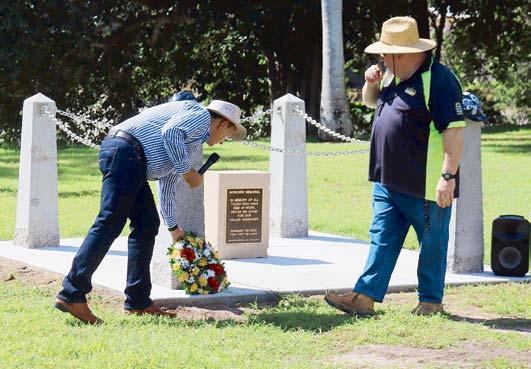
agreed on where it’s a bit more solemn and people can come and reflect, overlooking the Fitzroy River in a peaceful park rather than a playground park,” he said.
The memorial was funded through council capital budget funds, at a cost of $4000.
Having worked for 20 years in the meat industry, CrWilliams said he knew how dangerous jobs could be.
Attending the event on Monday, Senator Nita Green said Workers Memorial Day was an opportunity for employers and workers to commit to keeping their workplaces safe.
“We are lucky in Australia to have good laws that keep workplaces safe and secure but there is always more work that can be done.”
Senator Green said she was a lifelong supporter of workers unions and the work
they do, with both of her parents having been union members.
“We all know what it’s like to cut corners and sometimes we rush to get things done, as we try to do as best we can for our boss and our workplace,” she said.
“At the end of the day if workers don’t feel comfortable in the situation and they don’t feel safe, they have the right to stop work.”
An experienced project leader will head Critical Minerals Queensland (CMQ), a new office that will help grow Queensland’s burgeoning critical minerals sector.
Paul Holden has previously been a director at Townsville Enterprise and held senior roles with the Office of the Coordinator-General and the Department of State Development.
Based in Townsville, CMQ is a dedicat-

ed office to identify opportunities in the industry and foster discussions with proponents, investors, community members, and researchers.
“Queensland has a golden opportunity to capitalise on our critical minerals resources and our know-how to help the world transition to a decarbonised economy,” Mr Holden said.
“Critical Minerals Queensland will be a
key facilitator bringing together investors, industry and government together to grow this new sector that will bring new jobs and boost local economies throughout the state.”
Resources and Critical Minerals Minister Scott Stewart said the State Government has pinpointed Queensland as a global leader, supplier and manufacturer of critical minerals and renewable energy technologies.
“Our $245 million Queensland Critical Minerals Strategy is the starting point to making this vision happen and at the forefront will be Critical Minerals Queensland, an office dedicated to bringing investors, proponents, government and community together,” Mr Stewart said.
“I’m excited to have someone of Paul Holden’s calibre leading the office and helping Queensland’s critical minerals sector go from strength to strength.”

By Matthew Pearce and Karen Simmons
Member for Capricornia Michelle Landry
has blasted Prime Minister Anthony Albanese for “rewriting history” about road and infrastructure projects begun by the LNP.
During his visit to the Alpha HPA project in Gladstone on Wednesday, 17 April, Mr Albanese was questioned by a journalist about the Bruce Highway“failing basic safety standards”.
The Prime Minister said the Federal Government had committed $10 billion to the Bruce Highway, citing the government’s record on projects like the Rockhampton Ring Road.
“In the 2012 Budget I funded the study for the Rockhampton Ring Road. It only commenced this year,” he said.
“What happened in between time? The LNP, that’s what happened.”
Mr Albanese said the LNP had “talked and talked and talked” about fixing the Bruce Highway when they were in power.
“What they didn’t do was provide funds and get on with it,” he said.
“Just near here is the Calliope Crossroads - promised, funded, commenced, built, while I was the Infrastructure Minister.
“The Mackay Ring Road - I’ll be there again soon. Commenced under us, under construction.
“The Yeppen Floodplain into Rocky. It used to be that no one could get into Rocky every time there was a major flooding event, we fixed it.”
Mr Abanese said the Cooroy to Curra stretch of the Bruce Highway had previously been called “the most dangerous road in Australia”.
“It took us coming to government to get that done.”
Ms Landry said she was “sick to death of the lies told by the Labor Party”.
“Saying that the Coalition did nothing in their nine years in government is absolute garbage,” she said.
“The LNP put over $400 million into roads on the north and south of Rockhampton.
“And he knows full well that we put up the initial $800 million for the Rockhampton Ring Road.
“The Prime Minister is playing the Rockhampton community for fools if he thinks that they have forgotten his attempt to throw the Ring Road on the Labor scrap heap.”
Ms Landry said the stretches of the Bruce Highway between Mackay and Rockhampton and Rockhampton and Gladstone, which she drove regularly, were “atrocious”.
“He (Albanese) flies into these places, makes these grand announcements, but he doesn’t know what these roads are like,” she said.
“The wealth of the nation comes from us, the mining towns and cattle sector, and they

(the Federal Government) just keep bleeding us dry.”
She said the highway between Rockhampton to Gladstone was littered with “massive potholes”.
“I wouldn’t like to be travelling on that road at night time,” she said.
“People are getting killed on this highway. It’s an absolute disgrace.”
She said the situation would only get worse with heavy equipment regularly being transported overnight from Gladstone Harbour, including huge wind turbines for the Clarke CreekWind Farm.
Last month’s wet weather caused major damage to the Bruce Highway as well as other major roads.
TMR received 14 enquiries about potholes on the Bruce Highway between Rockhampton and Gin Gin between April 2 to April 9.
Ms Landry said TMR needed double the staff they currently have, including more engineers and more road crews.





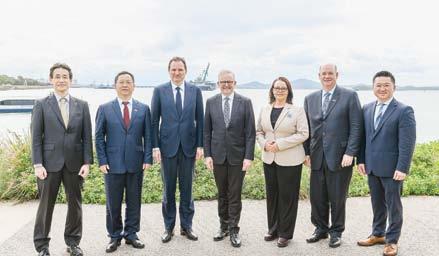
Australia Pacific LNG reached a massive milestone announcing the shipment of one thousand cargos out of Gladstone last month.
The 1000th milestone cargo departed Australia Pacific’s LNG facility on Curtis Island near Gladstone on the Cesi Gladstone, bound for China on Thursday, April 18.
Australia Pacific LNG chief executive of-
ficer Khoa Dao said the day marked a significant milestone for Australia Pacific LNG.
“We have reliably and safely exported 1000 LNG cargoes to our customers in Asia, while maintaining our role as one of the largest gas suppliers to Australia’s domestic market,” Mr Dao said.
“The path to today has been nothing short of remarkable, bringing together three
major energy businesses Origin Energy from Australia, ConocoPhillips from the United States and Sinopec from China.
“It’s a story of collaboration and determination to build a new export scale business supplying energy to the world and sharing benefits back with communities where we operate.”
In addition to creating local employment,
since the project was established Australia Pacific LNG has provided benefits in excess of $5 billion through state government royalties, local government rates, spending with local business, access agreements with landholders, and community investment.
Australia Pacific LNG is one of the largest gas producers, LNG exporters and domestic gas suppliers on Australia’s east coast.
By Karen Simmons
Prime Minister Anthony Albanese visited Gladstone last month to announce $400 million in new loans to Australian company Alpha HPA to deliver Australia’s first high-purity alumina processing facility in Queensland.
The Alpha HPA project in Gladstone is expected to create around 490 jobs during construction and more than 200 jobs on completion.
The loans will be provided by Export Finance Australia (EFA) through the Government’s $4 billion Critical Minerals Facility, as well as through the Northern Australia Infrastructure Facility and EFA’s Commercial Account.

Prime Minister Anthony Albanese, ministers, council and Alpha HPA staff celebrate Wednesday’s announcement.
Picture: SUPPLIED
here in Gladstone and in South Australia.
“These two critical minerals projects will help secure good and secure jobs in manufacturing, and clean, reliable energy.”
Resources and Northern Australian Minister Madeleine King said the Federal Government was committed to building the country’s critical minerals resources and processing industries to diversify global supply chains and help the world lower emissions.
Australia’s critical minerals industry.”
Gladstone Mayor Matt Burnett said the announcement further emphasised the importance of Gladstone Regional Council’s 10-year Economic Transition Roadmap, launched in November 2022.
“This is a fantastic announcement for the Gladstone Region as we continue our journey towards becoming the energy capital of Australia,” Cr Burnett said.
“We are building a future made in Australia with secure jobs in our regions. Today we are demonstrating what that means
Mr Albanese said while on site at the Alpha HPA facility in Yarwun that the global race for new jobs and new opportunities is on. “Our government wants Australia to be in it to win it,” he said.
“Australia’s critical minerals and rare earths are key to building renewable technologies such solar panels, batteries and wind farms, as well as defence and medical technologies,” she said.
“Gladstone is a city of great importance to the economic strength of northern Queensland and to the country and this project will put the city at the forefront of
“We are nearly 18 months into our Economic Transition Roadmap and this announcement demonstrates that it is working with three announcements within the past week.
“Council is proud to be leading the nation when it comes to responding to oncein-a-generation changes to our energy sector.”



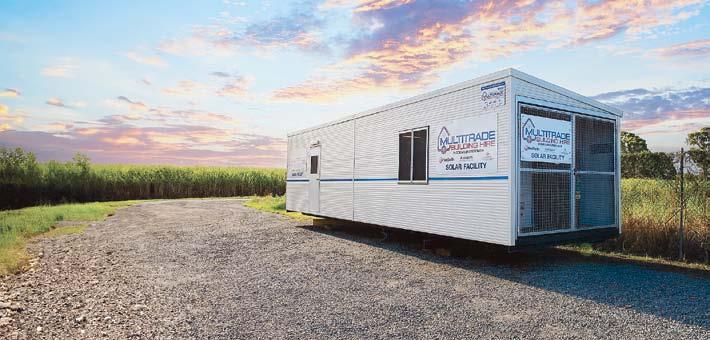
Multitrade Building Hire, a name synonymous with continuous innovation in the portable building sector, has launched a new benchmark for sustainability and efficiency in off-grid operational environments - The Solar Facility.
Designed in collaboration with Red Earth, a frontrunner in solar and battery technology, and with support from the Federal Government’s AusIndustry Entrepreneurs Program and the Department of Climate Change, Energy, Environment and Water, The Solar Facility is a testament to their continuous innovation in portable building solutions.
COMPLETELY OFF-GRID EFFICIENCY
The Solar Facility liberates operations from the constraints of traditional power sources such as generators and fixed site power.
This portable building is not just a workspace; it’s a self-contained power hub that promises unparalleled autonomy for industries.
ECO-CONSCIOUS AND COST-EFFECTIVE
Cost-effectiveness is at the forefront of The Solar Facility’s design.
The reduction in ongoing expenditures associated with generator rental, fuelling, and maintenance is substantial.
The initial costs for trade connections are also a thing of the past.
With the introduction of The Solar Facility, Multitrade Building Hire presents an opportunity for organisation to provide an operational environment that aligns seamlessly with the sustainability goals of their clients in the mining, construction, and industrial sectors.
NO DOWN TIME, IMMEDIATE ESTABLISHMENT
Immediate site establishment is now a reality, without the traditional waiting periods for external services such as electrical and plumbing connections.
The Solar Facility is perfect for a satellite building, a commandment centre for breaking ground on a new project.
INDUSTRY-DESIGNED, COMFORTFOCUSED
This is not just a building; it’s a tailored solution designed to overcome the unique challenges faced by mining, construction, and remote sites.
Gone is the hum of generators outside.
The Solar Facility offers a peaceful, efficient work environment enhanced with additional insulation for noise reduction and stable temperatures, contributing to a quieter, focused workspace that also maximises

•
•
•
•
energy efficiency.
BRIGHT, EFFICIENT INTERIORS
The interior space blends comfort with functionality.
High-efficiency appliances and LED lighting reduce energy consumption without sacrificing performance, and a broader 3.4m width provides a spacious and ergonomic flow.
ADAPTABILITY AND VERSATILITY
Flexibility is the essence of The Solar Facility.
The furniture layout is versatile, allowing for customisation to various operational requirements, whether it be as an office or a lunchroom, ensuring that the space evolves with the changing needs of its users.
CUTTING-EDGE ENERGY SYSTEM
At the heart of The Solar Facility is a state-ofthe-art solar battery system, comprised of 12 high-performance 390W solar panels and up to eight 4.1kWh Australian-made LFPTroppo batteries, ensuring ample energy storage and capture.
This system is not just about storing energy; it’s about ensuring a continuous and reliable supply, with the added benefit of remote monitoring through both computer and mobile dashboards, complete with builtin weather forecasting for energy production.
SPECIFICATIONS AT A GLANCE
· Solar Input: 12 x 4.7kW MPPT PV panels
· Power Output: 10,000VA continuous (@ 25°C), 20,000w peak power
· Battery Options: Up to 8 x 4.1kWh Australian Made LFP Troppo batteries
· Dimensions: 920L x 650W x 1680H (mm)
· Weight: 185kg without batteries + 42.5kg per battery
· BatteryVoltage: 48VDC nominal
· Electrical Connection: Hard-wired to local switchboard, auxiliary loads, backup
· generator compatibility
· Monitoring: RedEarth system with 4G SIM, customer monitoring on mobile/PC with PV forecasting
A SUSTAINABLE COMMITMENT FOR A BRIGHTER FUTURE
Multitrade Building Hire is not only setting a new standard with The Solar Facility; it’s reshaping the expectations for the industry at large.
This product is a physical embodiment of their commitment to a sustainable future and the continuous quest for operational excellence.
For more information, visit www.multitrade.com.au
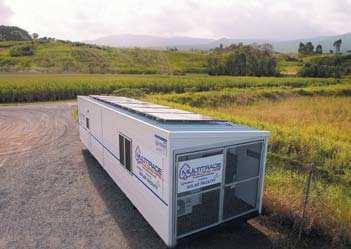


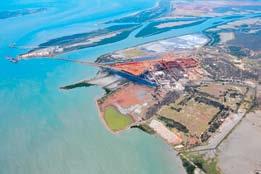
Queensland Alumina Limited (QAL) said it has made great strides to reduce environmental risks under the company’s Five-Year Environment Strategy during 2023.
Since the strategy commenced in 2018, $418 million has been spent, including $175 million within the Gladstone region, on more than 60 projects classed under key focus areas of dust, alkali, odour, water, land and noise.
“We’re moving our operations forward to keep in step with our community’s expectations for environmental performance,”
QAL general manager Trent Scherer said.
“To do this, our teams joined forces with global experts to problem-solve complex operational challenges and, last year alone, we brought over 30 projects into the completion phase.”
QAL has tackled dust emissions by adopting state-of-the-art dust containment technology on a brand-new alumina shiploader, implemented better controls on our alkali containment systems, expanded our water-holding capacity to more effectively treat onsite waste streams and engineered new systems to minimise major sources of
odour in the community.
“By retrofitting our complex 57-yearold refinery with the latest technology to achieve these great outcomes, we’re demonstrating QAL’s commitment to improved environmental performance, year on year,”
Mr Scherer said.
He added that the company’s operations play a “critical role in the aluminium production process, refining high-quality smelter-grade alumina from bauxite supplied by mines in Northern Australia, proudly supplying our product locally and around the world.”
With the remaining projects earmarked for completion in 2024 and 2025, QAL continues to remain focused on operating in a safe, stable and sustainable way for generations to come.
“The skill of our people and focus on continuous improvement ensures that we continue to create economic and social benefit for our region,” Mr Scherer said.
QAL is the fourth largest alumina producer in the world and has been operating for more than five decades in Gladstone.
Gladstone’s QAL alumina refinery will be bolstered by a $94 million energy efficiency upgrade as part of the Federal Government’s Powering the Regions Fund.
The funding will see the retrofit of a lowtemperature digestion circuit into QAL’s high-temperature unit to reduce coal and gas consumption.
When complete, it will be the first of its kind in Australia.
The Central Queensland project is the big-ticket item of a $330 million commitment to keep Australian industry not just surviving, but thriving as demand for low emissions products grows around the world.
“This investment in Australia’s hard-toabate manufacturing and mining facilities is about securing the future of high-quality, low-emissions products made right here,” Mr Bowen said.

“Northern Tasmania, Central Queensland and Western Australia have been industrial powerhouses for generations, and the Albanese Government is ensuring that continues.
“As global markets change rapidly – we’re supporting Australian industry to not only survive but thrive with our world-class products that support regional jobs across the country.”
The nine projects are tipped to create hundreds of new jobs during construction
and secure existing regional roles that have supported Australian families and communities for generations.
Mr Bowen said industries like cement, alumina, mining, iron and steel processing, chemicals manufacturing, and food processing are all critical not only to Australia’s past, but its future and future-proof the country’s heavy industries in a decarbonising world.
The other key projects include:
· $50 million to reduce emissions intensity at the Adbri cement manufacturing in Port Adelaide, SA
· $44 million for energy efficiency upgrades at Shoalhaven Starches food manufacturing in Nowra, NSW
· $35 million to power Murrin Murrin cobalt and nickel operations with renewables in Leonora,WA
· $32.9 million for emissions reduction at the CSBP chemical manufacturing facility in Kwinana,WA
· $15 million to electrify the Grange Re-

sources Iron Ore mine in Savage River, Tasmania
Mr Bowen said the projects would cut 830,000 tonnes of emissions every year, the equivalent to taking more than a quarter of a million cars off Australian roads.
Queensland Senator Murray Watt said the Federal Government was committted to delivering local jobs while making Queensland a renewable energy superpower.
“Gladstone is at the forefront of Australia’s critical mineral industry and we’re providing $93 million to help Gladstone’s iconic QAL refinery lower its emissions,” Mr Watt said.
“The double digestion project will reduce coal and gas consumption at QAL, cutting emissions by a huge 274,000 tonnes.
“A first of its kind in Australia, the project will create around 30 new full-time jobs for the Gladstone community and 600 jobs during construction.”

By Di Stanley
The introduction of larger jets on the Emerald-Brisbane route from mid-May by Qantas could see airfares fall by as much as 10 per cent.
The carrier will still fly the existing Dash 8 service, but is introducing the dual-class Embraer E190 to the regional route, growing capacity by 17 per cent.
At a Central Highlands Development Corporation lunch on Friday 20 April, Infinitum Partners director Kate Isles said airfares out of Emerald were“a very hot topic of late”.
“It’s one of those things that many people weren’t aware that Virgin do have a regional subsidy program, whether that’s highly utilised, we’re getting mixed reports,” Ms Isles, the author of the CHDC’s Workforce Development and Accommodation Strategy, said.
“From May, both airlines will have a new fleet into region, so the Dash8s are being pushed aside and we’re getting E190s and... what Qantas have said to us is there should be at least a 10 per cent drop (in fare prices).”
Ms Isles sand Qantas said all too aware that there was regular backlash to its regional pricing, and “they were listening”.
“Things like that viral post that went upthat immediately went to Qantas as another example of what’s happening in the region,” she added.
Lisa Collie sparked uproar on a popular Emerald social media forum when she gave Qantas a serve earlier this month, revealing she faced having to pay $3316 for two adult return flights from Emerald-Brisbane.
“Really Qantas!” she stated.
“This is two adults flying return EmeraldBrisbane.
“Out of on a Wednesday one week and back on a Wednesday the following week in a month’s time.
“How the hell is this justified?
“Yes, I was able to pick my return flight to another time of day, which would have meant eight hours in the airport after an overnight flight - just to save $1000.
“I know it’s a fight we’ve been having for years but mate….it feels like a blatant price gouge.”
The discussion thread exposed the fact most people were oblivious to Virgin Australia offering discounted fares for regional residents of 4720 with access to return fares from $300 (Choice fare - capped at $600 (Flex fare) on selected Emerald-Brisbane flights.
The deal is contingent on being a member of the free Velocity Frequent Flyer program.
CHDC business development officer Deb Barns said talks were underway with Qantas’s regional management to introduce a similar community scheme in Emerald.
“The latest conversation was off the back of a talent attraction group we had on Friday 13 April... this campaign is running off the

back of theWDAS and we’re obviously trying to attract talent into region and promote the Central Highlands as a great place to work and live,” she said.
“During that focus group there was some really interesting feedback around the lifestyle and airfares, a popular topic that consistently comes up.
“So this recent engagement with Qantas was around the awareness, or lack of awareness around their initiatives... like the larger fleet with the goal of increased capacity and it’s also going to be carrying a wet lease which impacts the staffing situation in terms of reliability.”
Ms Barns said she was urging Qantas to be part of the local conversation to better understand perception on the ground.
“You talk to some of the businesses here and they’ll bring a completely different spin on the airfare situation and how we can be
attracting talent into region, but when the talent gets here, they then become isolated... off the back of pulling in Qantas and engaging them quite frequently since the strategy has been released, they are having some serious internal conversations I believe,” she said.
“There’s a big push on why the Central Highlands is not included in the regional discounts for residents in certain regions and they (Qantas) consider us not to be applicable in that because of our FIFO ratio, which is still very high.
“The good thing is we have a very clear strategy.”
With fairer airfares one of the pillars of the Central Highlands WDAS, Ms Isles said a position paper was being developed to find cost reduction solutions with the airlines.
“Part of the work I’ve been doing around
these actions is monitoring that price point,” she said.
“We’ve been monitoring different dates at different times... and by 1 May is this actually going to see some price drops?
“We will be able to use that as part of our position paper to go back to Qantas and the airlines.”
A Qantas spokesperson told Emerald Today the introduction of the Embraer fleet would help keep airlines down and the carrier would continue to monitor and make adjustments to capacity where possible.
The Emerald Airport had a net earnings surplus of $2.778m to the end of March 2024 against a forecast surplus of $2.444m, a 14 per cent positive variance.
Year to date passenger numbers of 159,224 are up by three per cent on the same period last year, and up by six per cent on budget.
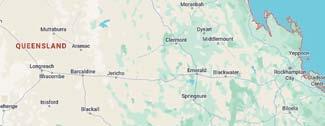


Students from the Gladstone region were fortunate to be the first to participate in an immersive workshop last week, exploring all components of the gas industry from exploration to transportation.
The Well to Wharf workshop was delivered by the Queensland Minerals and Energy Academy with the support of ConocoPhillips as the downstream operator of Australia Pacific LNG (APLNG).
Students from Gladstone, Toolooa, Tannum and Calliope state high schools, along with Chanel College, participated in the workshop held at the CQUniversity Glad-
stone campus onTuesday, 23 April.
Morethan50Year7studentsparticipated in the full-day program, which revealed the range of roles needed in the liquefied natural gas (LNG) industry from the gas fields to the tankers for shipping.
Queensland Resources Council director of skills, education and diversity KatrinaLee Jones said the QMEA team had specifically designed the workshop to showcase the intricacies of the industry and to inspire students to further explore their interest in science,technology,engineeringandmaths.
“A commodity like gas features in ev-
eryday activities for the students and this workshop gives them the backstory of where it comes from and how it gets into their homes,” Ms Jones said.
“The workshop aligns with theYear 7 science curriculum and gives the students a good understanding of the safety requirementsfortheindustry,pipelinelogisticsand export management.
“They will also get hands-on with a gas pressure experiment and have to use their calculationskillstoworkoutLNGtankerenergy capacity.”
ConocoPhillips stakeholder relations
manager Chantale Lane said they were proud to be sponsoring the first Well to Wharf workshop for the benefit of local schools.
“We know how important APLNG is for the regional economy and many of these students will have family members involved in our industry,” Ms Lane said.
“This workshop is a great opportunity to provide education on the LNG industry to the students as they start secondary school and may ignite their interest in further studies and even a career with the gas industry.”

A $1 million fund to enhance social and community life in the Isaac region was unveiled at April’s inaugural Pembroke Resources Community Expo in Moranbah.
Pembroke chairman and chief executive officer Barry Tudor said the Pembroke Community Partnership Program fund was created to ensure the local area continued to benefit from the opening of the Olive Downs Complex for generations to come, with funding being provided to projects identified, prioritised and supported by local residents.
“The Olive Downs Complex is already working in strong partnership with the local community by creating and supporting hundreds of jobs, prioritising local procurement whenever possible and providing our workforce with a genuine choice to live within the Isaac Region,” Mr Tudor said.
“This is stage one of the fund, which will run over the next five years to help ensure the local community reaps the benefits of having the Olive Downs Complex operating in their region. Projects of interest could include those focused on improved health, welfare and employment outcomes as well as improved social infrastructure.
“Another priority for us is reducing unnecessary red tape so it’s as easy as possible for locals to decide how and where this funding is spent for the future benefit of the community.”
Mr Tudor said the PCPP was in addition to other contributions the Olive Downs Complex was making to the region through job and training opportunities, local purchasing whenever possible and leading-edge environmental stewardship.
“The local community is rightly proud that the high-quality steel-making coal being produced by Olive Downs is supporting our national and state economies, as well as much needed infrastructure across

the world. Our Community Partnership Program will ensure those economic benefits are delivered at the local level as well,” he said.
Pembroke Resources has officially opened its Bowen Basin steelmaking coal mine that will generate more than $10 billion in royalties for the Queensland Government over its operational life.
Stage one of the Olive Downs Complex, which shipped its first coal to international customers in January, is on track to deliver six million tonnes of run-of-mine coal a year, ramping up to 20Mtpa at capacity.
Development of the $1 billion greenfield site supported 700 jobs with more than $60 million spent on around 20 local and 40 regional suppliers.
Pembroke Resources chairman and chief executive officer Barry Tudor said April’s opening was a chance to celebrate and recognise the people, including 600 current employees, who had been part of bringing the company’s vision for the Olive Downs Complex to life.
“From our early planning stages through to operations, we have applied a fresh approach to the development of the complex to exceed contemporary expectations of environmental management, conservation, emissions reduction, social responsibility and governance,” Mr Tudor said.
“We aim to be world leaders in terms of prioritising on-site technology, environmental protection and sustainability as part of how we operate.
“The Olive Downs Complex was the first mine to be approved under the Strong and Sustainable Communities Resources Communities Act, the first to build an integrated campus, the first with a three phase vegetation clearing protocol, and the first steelmaking coal mine in the world to implement CAT Command autonomous control for trucks and drills at the same site.

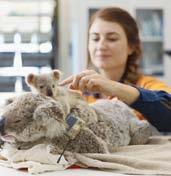
“Customer demand for the Olive Downs’ high quality steelmaking coal product is very strong.
“We are now focused on the next stage of expansion where we will double production as soon as possible.”
Mr Tudor said Pembroke’s approach continues to partner with government at all levels and the Bowen Basin community to create sustainable and long-term economic opportunity through job creation, economic diversification and direct community support.
“We remain committed to keeping our workforce as local as possible by giving our workers a genuine choice and the ability to live locally if they want to,” he said.
“We are proud of what we’ve achieved.”
Queensland Resources Minister Scott
Stewart said Olive Downs“ticked all the boxes” of a project that stacked up environmentally, socially and financially.
“I want to congratulate Pembroke Resources and acknowledge that by building this mine they are backing Queensland’s resources sector for decades to come,” he said.
Olive Downs has more than 500 million tonnes of coal reserves and up to 79 years of mine life,
Pembroke Resources acquired more than 40,000 hectares of land within and adjacent to the resource development zone, far beyond the land required for mining, utilised as a broad campus.
At the complex, Olive Downs has implemented a three-stage protocol involving three thorough checks for wildlife in the clearing process, employing teams of spe-
cially trained ‘spotter catchers’, drones and elevated work platforms and a dedicated Koala and Greater Glider Clinic staffed by specialist wildlife veterinarians and ecologists, focused on research, preservation and protection of these endangered species.
The complex also includes a planned 10-hectare solar farm and green energy project designed to offset power demand and promote sustainable practices and around 20,000 hectares of pastoral activities, fostering agricultural pursuits and land utilisation.
Other dignitaries attending the opening included Federal Shadow Minister for Resources Susan McDonald, Capricornia MP Michelle Landry, Senator Matthew Canavan and Queensland Shadow Minister for Natural Resources and Mines Dale Last.
Communities across regional, rural, and remote Australia can now have their say on telecommunications issues as public submissions open on the Regional Telecommunications Review.
The input of local communities will form an essential part of the review – held once every three years – which will see the Regional Telecommunications Independent Review Committee deliver recommendations to Government.
The review is closely examining the experiences of people in regional, rural, and remote parts of Australia with telecommunications delivery, as well as considering the unique needs of First Nations communities.
“Access to telecommunications services is critical for regional residents and businesses across so many aspects of everyday life – and we want to understand the lived experience of these services so that future policy actions are well-targeted and backed up by evidence,” review chair Alannah MacTiernan said.
“With technology changing rapidly we also want your ideas about how things can be improved and what would make the most difference for you and your community.
“We really encourage Australians in the bush to have their say via a submission or completing the survey in coming months, while we continue our face-to-face consultations across the country.”
Residents, businesses and community organisations can make a submission, with the Terms of Reference, announced by Minister for Communications Michelle Rowland MP, outlining key issues for the Committee to examine.
An issues paper has been released to help frame ideas.
“We are focused on how the universal service arrangements could be modernised to meet today’s needs, the potential of emerging technologies, the effectiveness of existing Government investment programs, and the improvement of telecommunications in emergencies,” Ms MacTiernan said.
Feedback from the public has been essential in previous reviews to ensure the committee’s recommendations are welltargeted and based on evidence.
For this review there are three options available to have your say: attending a faceto-face consultation, providing a formal submission or completing a survey.
The survey will be published in May.
Since March 2024, the Committee has visited Western Australia and Tasmania for face-to-face consultations with local issues also forming an important part of the committee’s considerations.
More locations for face-to-face consultations will be announced shortly.
The 2024 Review is being led by the Ms MacTiernan, former Western Australian Minister for Regional Development as Chair of the Review Committee.
She is supported by the Fiona Nash, Ms Kristy Sparrow, Dr Jessa Rogers and Mr Ian Kelly.
To have your say visit www.infrastructure.gov.au/have-your-say/2024-regionaltelecommunications-review
RegionalTelecommunicationsIndependent ReviewCommitteechairAlannah MacTiernan. Picture:SUPPLIED
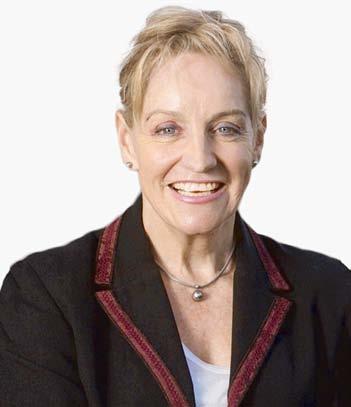
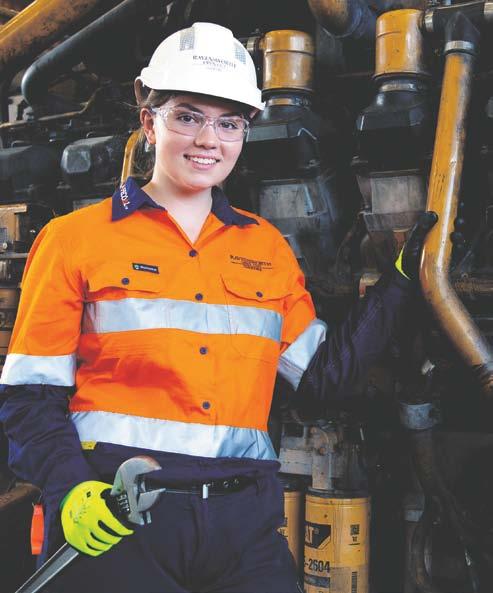
As‘tax time’ approaches, the Australian Taxation Office (ATO) has announced it will be taking a close look at incorrectly claiming work-related expenses.
In 2023, more than eight million people claimed a work-related deduction, and around half of those claimed a deduction related to working from home.
Last year, the ATO revised the fixed rate method of calculating a working from home deduction to broaden what is included, increase the rate, and adjust the records you need to keep.
These changes are now in full effect this financial year, meaning you must have comprehensive records to substantiate your claims as you would for any other deduction.
To use this method, you need records that show the actual number of hours you worked from home (like a calendar, diary or spreadsheet), and the additional running costs you incurred to claim a deduction (like a copy of your electricity or internet bill).
“Deductions for working from home expenses can be calculated using the actual cost or the fixed rate method, and keeping good records gives you the flexibility to use the method that works for you, and claim the expenses you are entitled to,” ATO assistant commissioner RobThomson said.
“Copying and pasting your working from home claim from last year may be tempting, but this will likely mean we will be contacting you for a‘please explain’.Your deductions will be disallowed if you’re not eligible or you don’t keep the right records.”
MrThomsonsaidtherearethreegoldenrules for claiming a deduction for any work-related expense:
1.You must have spent the money yourself and weren’t reimbursed,
2.The expense must directly relate to earn-

ing your income, and
3.You must have a record (usually a receipt) to prove it.
Mr Thomson said the ATO is focused on supporting taxpayers to get their lodgment right the first time.
“These are the areas that people are most likely to get wrong, and while these mistakes are often genuine, sometimes they are deliberate. Take the time to get your return right,” he said.
TheATOisalsowarningagainstrushingto lodge your tax return on 1 July.

If you have received income from multiple sources, you need to wait until this is prefilled in your tax return before lodging.
“We see lots of mistakes in July where people have forgotten to include interest from banks, dividend income, payments from other government agencies and private health insurers,” MrThomson said.
For most people, this information will be automatically pre-filled in their tax return by the end of July. This will make the tax return process smoother, save you time, and help you get your tax return right.
“By lodging in early July, you are dou-
bling your chances of having your tax return flagged as incorrect by the ATO,” Mr Thomson said.
“We know some prefer to tick their tax return off the to-do list early and not have to think about it for another 12 months, but the best way to ensure you get it right is to wait for just a few weeks to lodge.
“You can check if your employer has marked your income statement as ‘tax ready’ as well as if your pre-fill is available in myTax before you lodge. That way, an amendment doesn’t need to be made later, which could result in unnecessary delays.”










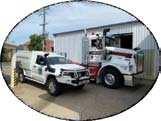




Beef2027 will be bolstered by a $4.5 million commitment in funding from the State Government, regardless who is in power after the 26 October election.
LNP leader David Crisafulli was in Rockhampton at Beef2024 to announce the increased support, if elected, to help cover increasing costs in staging the event which draws more than 100,000 visitors to the Beef Capital.
Mr Crisafulli said this event would again supercharge the Rockhampton and Central Queensland economies and deliver certainty for Beef Australia as planning commences for the next Beef Expo in 2027.
“Beef Week is a highlight on the calendars of so many Queenslanders who head to Rockhampton for this actionpacked event every three years,” Mr Crisafulli said.
“You bet we’re backing Beef Week.
“The LNP is passionate about agriculture in Queensland and Beef Week allows producers and businesses the opportunity to connect and learn more about cutting edge technology and innovation available to them.”
Mr Crisafulli welcomed the State Government’s call that it would match the commitment.
Premier Steven Miles said the 100 per cent funding increase further cements the iconic status of the triennial event.
“Queensland is Australia’s premier food bowl and there’s no better example than our beef industry,” Mr Miles said.
“Queensland is home to almost half Australia’s cattle herd and beef is our most valuable agricultural export, worth some $7.1 billion a year.
“Beef produced in Queensland is con-

sumed in more than 60 countries around the world and it’s little wonder as it’s the best-tasting, cleanest and greenest beef in the world.
“Our beef industry is worth $10 billion a
year and supports 40,000 jobs, which is why we’re increasing our support for Beef2027 and the Queensland beef industry.”
Agricultural Industry Development Minister Mark Furner said Beef Australia has
spread the message about Beef since 1988.
“This government is taking its partnership with industry to the next level with this extra funding, which will further strengthen an already thriving beef sector.”



“Thank God gentlemen, the verdict is yours, not mine.” Judge CharlesWilliam Blackeney, Roma, Queensland, 1873.
Was this verdict, widely published and criticised in Sydney, Melbourne and Brisbane newspapers, the first widely documented revelation of, that different being, the Queenslander?
‘They’re different up there,’ ‘that’s Queensland for you - out of line with (10 years behind) the rest of the country.’ ‘All troppo.’
We’ve all heard this (and worse), but to most of us its water of a ducks back. We are proud to be different. But where did this‘difference’ perception come from and what is it that makes us, if we are, ‘different’, a Queenslander?’
Words that you arguably associate with favorably generalising a Queenslander include; independent, defiant, self-reliant, audacious, capable, able to adapt to harsher environment, resilient, thumbs their nose at the establishment.
Of course these are not words that describe all Queenslanders, (or all Queenslanders aspire to), and the imagery associated with them is typically outback (remote) related, the lone cattle drover, not in cities where most of us now live.
The words and hazy visualisation of a Queenslander relate more to the late 1800s than the 21st century, but we are still generalised as being different.
Remember former Queensland Premier, Anna Bligh’s 2011 flood speech!
Of course we do not mind expounding on this difference as well.
Is it just co- incidental, in the same month we acknowledged and celebrated the Beef Industry, huge contribution to the national economy, its past, and future, in the same part of the state, Central Queensland, we were to again celebrate the world’s greatest cattle duffer?
Who celebrates a cattle duffer, one from 154 years ago? And if he was found not guilty, does that not mean, he did not do it! Only in Queensland!
It is a story many of us have heard about, and the western Queensland towns of Aramac and Roma, enjoy re-telling, the story of Harry Redford, the world’s greatest cattle duffer and a white bull purchased from Gracemere station, just west of Rockhampton, Australia’s Beef Capital, and host of the tri-annual, Beef Australia, the biggest beef expo in the southern hemisphere.
But, what about the 12 men, who in 1873 sat in the Roma courthouse for around 13
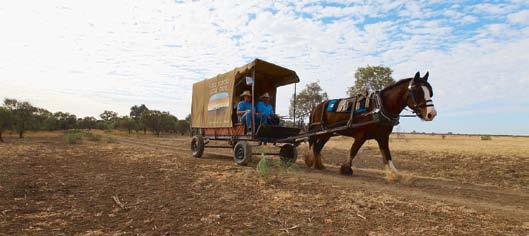


hours, heard overwhelming damning evidence against the accused, Harry Redford, did not hear from one defence witness, as there were none, deliberated for one hour, and found him not guilty, which on repeating, Judge Blackeney uttered his thanks to God.
The jury then supposedly carried (the near 2m tall) Harry on their shoulders from the courthouse, past the disputed white bull tied up outside, over to the pub where Harry shouted them drinks, perhaps from the remainder of his share of the 10000 pounds that they just indicated he had not received from the sale of the stolen cattle.
Are these 12, widely criticised in the nation’s newspapers (even in Brisbane), the first to nationally symbolise the Queensland ‘difference?’
As it is widely accepted Harry was found not guilty because the 12 jurors were in
awe (along with the others that knew of the drive) at the audacity, skill, and self-belief to do this.
Not that they had any doubt he had done it. (The co-accused had previously also been found to be not guilty).
The widespread reporting of this mutual admiration, the Roma 12 opportunity to thumb their nose to the court (establishment), by delivering such an incredulous verdict, along with what Harry and his two accomplices had achieved, placed a picture in the nation’s mind (New South Wales and Victoria particularly) of (that new species) a Queenslander (the state being only 14 years old).
Reinforced, in part, later years by words of Banjo Patterson, and the like, with poems (songs and books) reminiscent of Clancy of the Overflow (void of the mention of flies, heat and saddle soreness). Overtures which
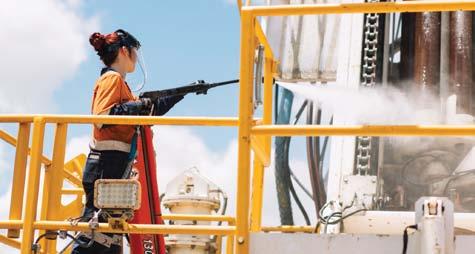
still endure today.
And now, 154 years after the alleged remarkable drive of 1000 stolen cattle across largely unchartered land, from Aramac, Central Queensland, to Marree, South Australia, done mainly at night, using the stars as guides, you had the chance to ride a horse, beside cattle (not stolen), on a small part of this infamous 2000km cattle drive.
The 2024 Harry Redford Cattle Drive unfortunately has been cancelled, in part due to low bookings, but if you are interested in being a future participant, follow the Harry Redford Cattle Drive Facebook page for updates.
After all, it is more than just authentically reliving an infamous cattle drive, it is learning about when and how, the rest of the nation started believing Queensland and those who live in it, are different.
‘Thank God, we are, hey Judge Blackeney.’

WITH WENDY HANNAN

In Central Queensland, keeping tabs on the job scene is serious business.
Every month, Jobs and Skills Australia conducts surveys with over 1,000 employers, giving us the lowdown on what’s happening in the employment arena. This data isn’t just valuable for job seekers; it’s essential for understanding employer needs and market trends.
The most recent data showed a consistent level of hiring activity, with 49 per cent of employers indicating they were on the lookout for new talent – the same as the previous month.
However, compared to the same period last year, there’s been a slight decline of about six percentage points.
While major urban areas experienced a marginal drop in recruitment, regional areas saw a modest increase, illustrating the regional variations in employment dynamics.
Despite the steady hiring pace, recruitment remains a challenge for many employers.
While there was a slight improvement in the proportion of employers facing recruitment difficulties for the second consecutive month, half of them still reported encountering obstacles in finding suitable candidates.
When it comes to business size, larger enterprises appear to have an easier time navigating the recruitment landscape compared to small and medium-sized businesses.
However, both face their own set of challenges, underscoring the complexities of the hiring process across different business scales.
In a region characterised by diverse industries, here in Central Queensland, employers seeking candidates with higher skill levels continue to encounter difficulties, with 62 per cent reporting challenges in filling positions requiring advanced skills.
This highlights the importance of ongoing skills development and training initiatives to meet industry demands effectively.
Looking ahead, there has been a notable adjustment in employers’ staffing outlook.
The proportion of employers anticipating an increase in their workforce over the next three months decreased by four percentage points to 22 per cent.
Conversely, there was a slight uptick in the percentage of employers expecting a decrease in staffing levels, signalling a need for flexibility and adaptability in workforce

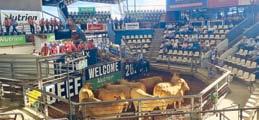
planning.
A SNAPSHOT OF RECENT DEVELOP-
Central Queensland is gearing up for a wave ofeconomicgrowth,withseveralmajorprojects set to create hundreds of jobs across the region. From renewable energy initiatives to infrastructure upgrades, these developments promise to inject vitality into the local economy and support the region’s transition towards a more sustainable future.
The federal government’s commitment to bolstering Australia’s critical minerals sector has materialised in significant funding allocations for projects in Queensland and South Australia. In Gladstone, Australia’s first high-purity alumina processing facility is slated to receive a substantial boost of $400 million in loans.
This investment, part of the federal government’s $4 billion Critical Minerals Facility, underscores the importance of securing a domestic supply chain for critical minerals essential for renewable technologies.
Renewable energy takes centre stage in Central Queensland with the commencement of construction at Acciona Energia’s
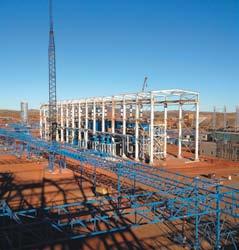

Aldoga Solar Farm near Gladstone.
With an investment of $500 million, this project is expected to generate up to 350 jobs during its 18-month construction phase, providing a significant boost to the local economy.
Set to be operational by mid-2026, the solar farm will contribute to Central Queensland’s renewable energy capacity and support the region’s transition towards a low-carbon future.
The project’s significance extends beyond its environmental benefits, with the energy generated earmarked for powering the proposed Central Queensland Hydrogen Hub. This integrated approach to renewable energy production underscores the region’s potential as a hub for clean energy innovation and industrial development.
Central Queensland’s beef industry is also set to receive a major infrastructure boost, with $500 million allocated for upgrades to priority road corridors. In partnership with the federal government, the Queensland government aims to improve road infrastructure vital for the beef supply chain, enhancing safety and efficiency for livestock transporters across the region.

An early works package targeting key road projects is in the pipeline, with construction expected to commence progressively from 2024-25.
These investments not only support the beef industry’s growth but also contribute to the broader economic development of Central Queensland, ensuring the region remains a cornerstone of Australia’s agricultural sector.
Central Queensland is experiencing transformative change. These initiatives not only promise to create jobs and drive economic growth but also position the region as a leader in sustainable development. With a focus on innovation and collaboration and an agile and responsive workforce, the CQ region remains poised to seize emerging opportunities and sustain its trajectory of growth in the years ahead.
Jobs in Central Queensland offer a holistic approach to your recruitment and talent attraction requirements. For more information and insights about local job opportunities and recruitment support visit JobsinCentralQueensland.au
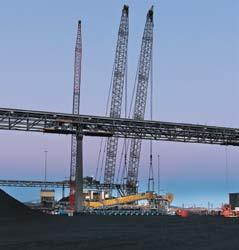
By Capricornia Chamber of Commerce
president Jason Foss
May is Small Business Month, so aside from all the roadshows and events around the state, what does that actually mean?
Allow me some literary licence, and I’ll swap out Small for Local. For now, let’s call May “Local Business Month”.
What can we do to support Local Business Month then? My answer consists of more questions, I’m afraid!
Next time you buy meat or produce from a big supermarket chain (more on them later), ask yourself: Can I buy this from a local butcher or grocer instead? By doing so, you’re not just supporting a local business, but also investing in your community’s economy.
Next time you’re tempted to visit amazon.com, ask if you can get it locally instead. Are you using an accountant or other professional advisor out of Brisbane? There are many high-quality local options available, and by choosing them, you’re contributing to the growth and prosperity of your local community.
Another reason to consider small or local options is the power of consumer choice. What happens when the big players get bigger? Many sectors are already effectively a duopoly.
Think about the power and control centralised between the two main supermarket operators. Coles andWoolworths have spent time in the news this year, accused of anticompetitive behaviour. The Australian Consumer and Competition Commission won’t be handing down its interim report until August, but it’s a timely reminder of the impact our choices can have.
Then consider Bonza’s recent demise.
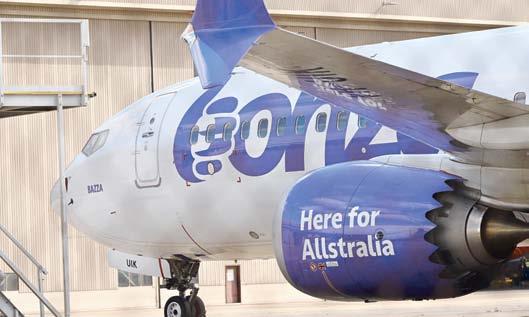
Our airline industry is effectively another duopoly example, and this industry in particular has seen a few other airlines try and fail to make a permanent impact over the years. It’s a tough gig.
While we’re on the topic of tough gigs, the small business environment is very com-
petitive - even more so recently with the increase in cost of living - and so they need your support now more than ever.
It’s the small and local business that will sponsor junior sports teams and support local charities and fundraisers. They are vital to the community.
And if you are running a small or local business and feeling the pinch (as I know many of you are) please don’t forget there is help available. You’re not on your own. Visit capricorniachamber.com.au or reach out and we’ll put you in touch with the right people.





RACQ CapRescue, the leading aerial emergency response service in Central Queensland, is thrilled to announce a new partnership that will bolster its operational capabilities and enhance community support. Partnerships play an integral role in CapRescue’s ability to serve the region effectively. Without this generous support, the lifesaving missions would not be possible. This financial backing ensures that the Rescue300 helicopters remain in the sky, ready to help those in need across Central Queensland.
“Our commitment to serving the community is unwavering, and we’re deeply grateful for the support we receive,” said CapRescue Operations Manager Kirsty Wooler.
“It’s truly a win-win situation – by partnering with us, organisations not only contribute to a vital service but also elevate their own standing within the community.”
CapRescue offers multiple levels of partnership, each making a significant contribution and a real difference. Current and past partners have played a crucial role in the more than 10,000 rescues that have been performed since the company’s inception in 1996.
With the average daily rescue number increasing, new partnerships are essential and Jemena, a leading Australian energy infrastructure company, has heard the call. Through this collaboration, Jemena will join as a Liftoff partner, providing crucial support to CapRescue’s life-saving missions across the region of 350,000 km2.
As a company managing significant gas and electricity assets in various parts of eastern and northern Australia, Jemena recognises the importance of community welfare and well-being. They are committed to making a positive impact in the communities where
they operate by supporting not-for-profit and community organisations.
CapRescue, a community-based, not-forprofit registered charity, plays a critical role in Central Queensland by rapidly deploying medical and rescue teams to major accidents, workplace incidents, and inter-hospital transfers.
In 2023/24, CapRescue’s operating costs are estimated to be $12.5 million, with 40% of the funding reliant on partnerships, fundraising, events, and donations. With helicopters equipped with full aeromedical and counter disaster capabilities, CapRescue can access and rescue individuals in environments where conventional methods fall short.
Ms Wooler said that Jemena’s partnership will support an essential service that operates 24/7, 365 days a year, free of charge to Queensland residents.
“Partnerships like the one with Jemena are crucial for sustaining our life-saving organization. We are thankful for the support we receive that enables us to continue flying, ensuring that no one is left without critical assistance during emergencies.”
To learn more about our partners and how you can support our mission, please scan the QR code below:


By Matthew Pearce
With Beef 2024 fast approaching, Central Queensland’s LNP politicians have called on the Federal Government to restore the original timeframe for the much-needed beef corridor upgrade.
It was revealed in Senate Estimates in February that the planned $400 million upgrade that would see 457km of beef supply network roads sealed had been pushed back from a start date of 2025/26 financial year until 2027/28 financial year.
The new plan means the Federal Government has budgeted $50 million for 202728, $50m for 2028-29, $100m for 2029-30 and 2030-31, with $100 million allocated to 2031-32.
Senator Matt Canavan said the beef corridors project was the initiative of seven regional councils, who met ALP and LNP representatives at Beef 2021.
“Both sides of politics said they would support them, promising $400 million, an election promise, but Labor are breaking the promise they made to the beef sector,” Senator Canavan said.
“Their own officials have not even been to Central Queensland to meet with local officials to drive the roads.
“I don’t want to see these Labor politicians come up to Beef Week and bring their big hats, they should bring their big cheques so that we can finally seal these roads for beef producers.”
Member for Capricornia Michelle Landry said Central Queenslanders were sick of being “poor cousins” to the south-east and Canberra.
“The beef sector, the mining sector and the agricultural sector provide all the dollars for these people to spend, but they spend it
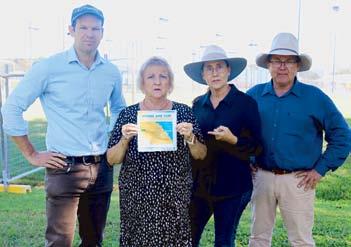
down there, they don’t spend it up here.”
Ms Landry said she had just come back from a trip out west on the Old Bruce Highway, which she said was full of deep potholes.
“For the first time in 11 years I got a flat tyre from these roads,” she said.
“I’m appalled. People are driving these roads daily and they’re very dangerous.They need to get moving on this.”
LNP candidate for Capricornia Donna Kirkland said every delivery that was delayed because of poor roads was another
dollar the consumer paid at the plate, with reports of shipments being delayed for days or even weeks.
“Primary producers are disadvantaged because they supply $1.7 billion to our economy yet up to 78 per cent of their gross profit is reduced by ongoing problems with the road network,” she said.
“It doesn’t give much confidence to our consumers who are in the middle of a cost of living crisis right now.
“And let’s not forget the animal welfare side of it, as roads being sealed and safe is
better for the animals as well.”
Member for Flynn Colin Boyce said the decision to push the $400 million commitment to the “end of this decade” was “absolutely crazy”.
“This was an election commitment they said they would honour and it’s quite clear they have no regard for agriculture at all,” he said.
“What we’ve seen from the Labor Government time after time is that they put more taxes on agriculture and put more hurdles in front of them.”
Federal Infrastructure Minister Catherine King said there had been no cuts to the $400 million committed by the Australian Government for the Beef Roads projects.
“CentralQueenslandandtheQueensland beef industry will benefit greatly from the delivery of $500 million of upgrades to priority road corridors and I’m very keen to see the projects get started,” she said.
“Currently, the Queensland Government is consulting local councils on the delivery of this program of works and the Australian Government’s funding is ready to flow once Queensland is ready to deliver the program of works.
“I note that the Queensland Government announced an early works package focused on initial priorities on 13 March.” Roads that are assigned to be sealed under the upgrade include Clermont-Alpha Rd, May Downs Road, Kilcummin-Diamond Downs Road, Alpha-Tambo Rd, Dawson Developmental Rd, Fitzroy Developmental Rd (Bauhinia-Duaringa), Fitzroy Developmental Rd (Taroom-Bauhinia), Duaringa-Apis Creek Rd and the Glenroy Road Corridor (incl. crossing).
Federal opposition leader Peter Dutton stressed striking the right balance between farming and renewables is required during the first day of his visit to Central Queensland.
Mr Dutton was joined by Nationals leader David Littleproud, Flynn MP Colin Boyce, Capricornia MP Michelle Landry, Senator Matt Canavan and Senator Susan McDonald at the Kalapa property, located in close proximity to the Moah Creek Solar Farm.
“They’re a young couple (on this property) that we spoke to, who just bought 300 acres and starting off their dream,” Mr Dutton said on Monday, 6 May.
“Their dream, though, has been shattered because the picturesque background that you see behind us is now going to be littered with wind turbines, at least 275 metres out of the ground.
“I’m in support of renewable energy, but as part of a mix, and I want to make sure that we can bring prices down for Australians.
“These wind turbines are going to drive up the cost of electricity, they’re going to make it less reliable, which means we’ll lose manufacturing, and it means that we will have less green power, ultimately, because we can have a sensible energy mix as we’re proposing, and we can bring those prices down, have reliable and greener energy through what the Coalition’s proposing.
“At the moment, the Prime Minister has absolutely zero regard for people who are living in regional areas, and I think we’re here today to call that out.”
Mr Dutton said during his visit to Beef2024 and Kalapa that farmers told him they’re happy to contribute to a decarbonisation of our community and energy system.
“They’re happy to be responsible in the way in which they can contribute to that
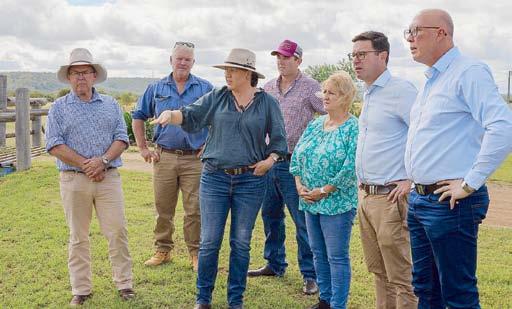
debate. The farming practices that have changed over the course of a generation have been quite dramatic,” he said.
“The farmers in Australia are the greatest friends that the Australian environment’s ever had. They want to see the environment survive and thrive because it’s absolutely integral to their own success and the success of generations to come, but they don’t want their lives destroyed.
“When you think about 60 wind tur-
bines, 270 metres on top of those mountains already, that destroys the vista. It’s amazing that there’s no environmental impact, really, that’s considered. It’s not impact assessable under the Planning Act, it’s code assessable, which means that neighbours don’t have to be consulted.
“If you want to go and build a block of units, or you want to build a shopping centre somewhere or open a mine, you need to go through a planning process.You need to
engage with the community, you need to explain how it is that your project is going to impact on the environment, and on that local community. None of that takes place here. Instead, the photos that we saw before, you’ll see the tops of these mountains cut off.
“That’s why I think we need to be honest with the Australian people about the cost of the Prime Minister’s folly of a ‘renewables only’ policy.”
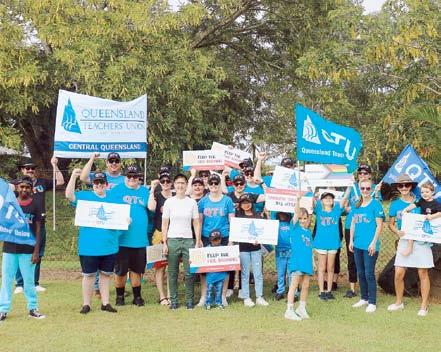

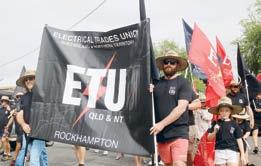
By Matthew Pearce
About 200 representatives from various unions took part in the 2024 Rockhampton Labour Day march on Sunday, 5 May, with relief as the rain held at bay until the afternoon.
Holding placards and chanting slogans, the marchers leftWoods Park, heading down Card Street towards Musgrave Street, then along Musgrave onto High Street, turning left onto Victoria Place back towards Miles Street.
While the march had previously departed from Kershaw Gardens, organisers felt the Musgrave St route would increase its visibility.
The march concluded back at Woods Park for a family fun day.
Queensland Council of Unions Rockhampton general secretary Ethan Ives said while Rockhampton had a lot of staunch unionists in town, the annual commemoration of workers’ rights was often taken for granted by the general public.
“I think it’s important to demonstrate that solidarity and unity in the union movement and to really show what we’ve actually accomplished as unions, from gender pay equity to superannuation and Medicare,” he said.
“It’s also an opportunity to gather and reflect on what we are going to be doing for the next 12 months.
“For us, the focus is going to be the state election and what we need for Central Queensland.”
Mr Ives said while the march was on Sunday this year because of Beef 2024, the Labour Day events would return to the public holiday next year, with plans for it to be“bigger and better”.
On the day, Deb Wynne was presented with this year’s Alan Bambrick Unionist of the Year Award, named for the proud Rockhampton Labor supporter and Rail, Tram and Bus Union member, who passed away in 2022.
The event was attended by Australian Council of Trade Unions national secretary Sally McManus, who delivered a “rousing speech” to the assembled unionists.
Mr Ives said there was a long and rich history of Labour Day events in Rockhampton and Central Queensland, with the tradition dating back to 1905.

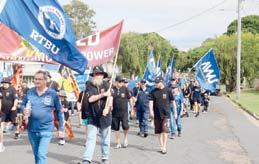




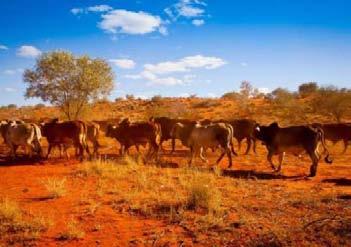

Rabobank’s annual Australian Farmland Price Outlook is forecasting further growth in the year ahead, but at a slowing pace.
The global agribusiness banking specialist has pinpointed after three consecutive years of “double-digit” growth, the momentum in agricultural land price increases is expected to further slow in 2024, as farm profitability levels come off record highs.
And the price outlook is mixed across sector types and geographical regions, the bank says.
Rabobank is forecasting a “base case” increase of approximately five per cent in the median price per hectare of all agricultural land types nationally in the year ahead.
“Land prices will maintain their growth trend, but not for all sectors and regions,” the report states.
The bank’s analysis – of a data set sampling commercial sales across the country – showed while the median price of agricultural land per hectare nationwide grew at a rate of 10.9 per cent in 2023, this was down on the stellar growth rates of 28.6 per cent and 27 per cent seen in 2022 and 2023 respectively.
Report author, RaboResearch analyst Vitor Pistoia said this slowing growth trend in agricultural land prices reflected a “maturing land market”, with a less bullish outlook for farm profitability, along with weather challenges and a tighter supply of available properties.
“Australia’s farming sector experienced an unprecedented positive cycle from 2020 to early 2023. Record-high commodity prices and plentiful rainfall supported profitability, which boosted farm business equity and confidence in a brighter future,” he said.
“Outside investors joined this booming sector and turbo-charged competition for land, supported by low interest rates. The land market suddenly had many participants bidding – farmers willing to expand, investors pursuing capital gains and companies looking to invest in the carbon credit sector.”
On the flipside, Mr Pistoia said, farmers willing to exit the industry had used the opportunity to sell at rising prices, adding to the supply of land available for the increased demand.
Now, he said, the agricultural land market is finishing this cycle and starting a new one, where the number of farms for sale and bidders is lower than before, and the financial outlook for the sector, while overall strong, is not as positive.
2023 agricultural land prices reflected a “tale of two industries”, according to the report, with the median price for arable (cropping) land rising 20 per cent, while grazing land remained virtually stable, with the me-
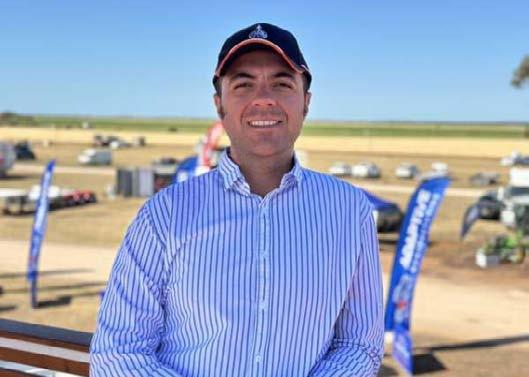
dian price slipping 0.3 per cent.
Mr Pistoia said the contrasting price movements seen across the different land types reflected the fortunes of the sectors during the year, with cattle and sheep commodity markets suffering a considerable decline.
The data analysed indicated the number of agricultural land deals fell in 2023, with national sales declining 35 per cent.
Agricultural land price movements varied across the country in 2023, the report found, with year-on-year growth in the median price per hectare in New South Wales (six per cent), Queensland (four per cent), South Australia (one per cent) and Tasmania (eight per cent).
Western Australia was a stand-out – the only state to surpass national median agricultural land price growth, with a 48 per cent increase in the year.
At the other end of the spectrum though, Victorian agricultural land prices declined
overall – by eight per cent – “primarily impacted by the ebb and flow of the sheep and cattle markets,” the report said.
Mr Pistoia said overall agricultural land price growth in 2023 had been “more supported by the equity that had been built in past years than the profitability outlook for the farm sector”.
And interest rates remain an elevated cost, with further increases considered likely and no relief in sight.
“Some regions might see a decline in winter crop production on the back of a dry start of the season,” Mr Pistoia said.
“But the chance of a La Nina in the second half of 2024 offers a potential tailwind for cropping operations. Beef production is poised to expand on the back of good rains in large swathes of northern Australia.
“Commodity prices are still slightly above historical averages for a number of sectors, albeit down from record highs seen in recent years. Improved cattle prices and a bet-
ter market outlook also mean grazing land should partially recover its price growth pace.”
The longer-term outlook for agricultural land prices – for 2024 to 2029 – indicates a further slowing, the report said, with a gradual reduction in price growth, as buyers seek out the “best value for money”.
But the forecast is still optimistic.
“The long-term view is crystal clear –farmland is in demand,” Mr Pistoia said.
“The pivotal point for the land market now is how to properly evaluate the ‘risk-reward’ scenario for such a long-term investment.”
And while the growth rate in agricultural land prices is slowing, Rabobank does not foresee a drop in land values in its forecast.
“A drop in land values would require widespread drought, serious economic hurdles and/or disease outbreak – none of which is on the horizon fortunately,” the report states.